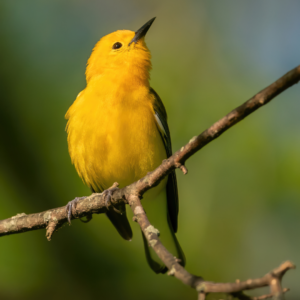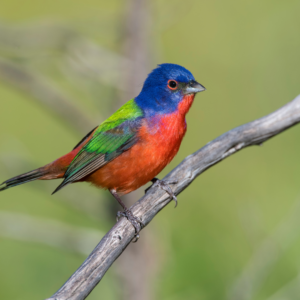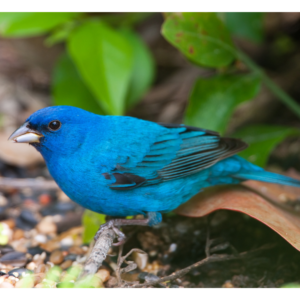It’s time to turn out your lights Louisiana because the fall bird migration is in full swing.
Thousands of Louisiana residents, business owners, and building managers participated in Louisiana Wildlife Federation’s Lights Out Louisiana program during the spring migration. Their simple act of turning off external and internal lights helped more than 450 million birds successfully navigate Louisiana’s tall buildings and homes to reach their nesting grounds elsewhere in the United States and Canada. Now it’s time for the return trip south. But the fall migration has an added twist. As with all fall migrations, this one includes new fledglings – approximately 50 million of them – making their very first trip.
According to Dr. Erik Johnson, Director of Conservation Science of the National Audubon Society’s Louisiana office, we’re off to a good start with many warblers appearing earlier than expected.
“From August 1st to September 17th, Cornell University’s BirdCast has estimated that an above-average 179.2 million birds have migrated through or over Louisiana, mostly on their way to Central and South America,” said Johnson. “But, sadly, many of these birds—estimated at more than a billion a year in North America alone—will die in collisions with buildings.”
This is why The Louisiana Wildlife Federation (LWF) is calling on residents and businesses throughout the state to join others in turning off bright or excess lighting from 11 p.m. until 6 a.m. each day from now until November 1st to help protect the billions of migratory birds that fly through Louisiana at night during this period.
Louisiana sits within the Mississippi Flyway migratory path, with the state’s vast wetlands, forests, and coastline serving as critical stops along the birds’ migration routes. Twice a year, 325 bird species travel the Mississippi Flyway, including 40% of shorebirds. During the 2023 fall migration, an estimated 500 million birds migrated through the state of Louisiana. The majority of those birds migrate at night and typically start their nightly migration about 30 to 45 minutes post-sunset, with peak flights between 10 and 11 p.m.
While the dark skies allow the migratory birds to avoid predators, take advantage of calmer air and utilize the moon and stars for navigation, it also brings with it other dangers such as bright artificial lights and the skyglow from larger cities that can confuse the birds, often causing them to fatally collide into buildings or windows.
“Our city lights can misguide birds, diverting them off course with often dire consequences. This initiative is an easy yet impactful step in helping these birds continue their incredible journey,” said Rebecca Triche, executive director of LWF. “Louisiana is well-known for the populations of migratory birds we see here at different times of the year and people care about keeping wildlife sustainable. By supporting the Lights Out initiative, businesses and individuals can take a practical step to protect the birds that briefly call Louisiana home.”
According to news reports, one building in Chicago was responsible for as many as 1,000 bird collision deaths in one night last October. These deaths can easily be avoided by simply turning out or turning down exterior lighting.
At LWF’s February 2023 Board of Directors meeting, the organization passed Resolution #2, 2023 Lights Out to Save Migrating Birds requesting that “all public buildings observe ‘lights out’ as official policy of the State of Louisiana, City of Baton Rouge and other governmental entities.”
Individuals and organizations wanting to join others in the Lights Out Initiative should follow these guidelines:
- Turn off non-essential lights nightly from 11:00 m. to 6:00 a.m. during the migration period.
- Avoid using landscape lighting on trees or gardens where birds may be
- For essential security and safety lighting, use these dark skies-friendly lighting adjustments:
- Aim lights downward.
- Use light shields to direct light downwards and prevent an upward glare.
- Use motion detectors and sensors so lights turn on when needed.
- Close blinds at night to limit the amount of light seen through windows.
- For building owners/managers:
- Adjust custodial schedules to be completed by 11:00m.
- Ensure lights are turned off after custodial cleaning.
Additional Guidelines for Buildings Over 3 Stories:
- Dim or turn off:
- Exterior/decorative lighting.
- Lobby/atrium lights.
- Perimeter room lights on all levels.
- Floodlights.
- Lighting on interior plants/fountains.
- Lights on vacant floors.
- Lights with blue-rich white light emissions (over 3000 K in color temperature.)
- Instead use:
- Desk lamps or task lights instead of overhead lights.
- “warm-white” or filtered LEDs outdoors (less than 3000 K in color temperature.)
Migration routes, along with the timing of the flight, can vary from day to day due to a number of factors such as the weather conditions.
Individuals can monitor the bird migration in their area by using BirdCast, a migration dashboard provided by The Cornell Lab of Ornithology. Dashboards for Louisiana and selected cities are:
- Louisiana – https://dashboard.birdcast.info/region/US-LA
- Alexandria – https://dashboard.birdcast.info/region/US-LA-079
- Baton Rouge – https://dashboard.birdcast.info/region/US-LA-033
- Houma – https://dashboard.birdcast.info/region/US-LA-109
- Lake Charles – https://dashboard.birdcast.info/region/US-LA-019
- Lafayette – https://dashboard.birdcast.info/region/US-LA-055
- Monroe – https://dashboard.birdcast.info/region/US-LA-073
- New Orleans – https://dashboard.birdcast.info/region/US-LA-071
- Shreveport – https://dashboard.birdcast.info/region/US-LA-017
Examples of Migratory Birds Flying over Louisiana this Fall





